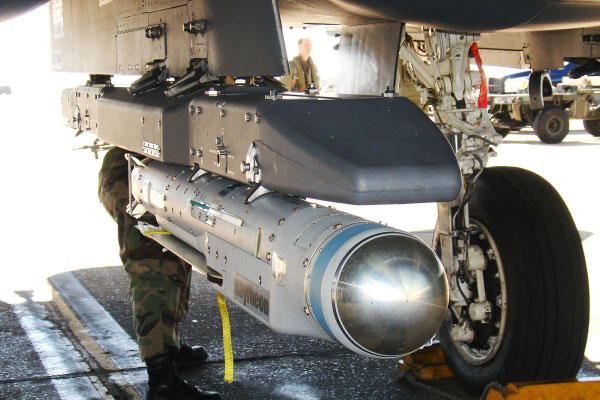An Air Force F-15 Eagle recently destroyed a moving -model T-72 tank during a live-fire test of the Small Diameter Bomb II at White Sands Missile Range, N.M., service leaders said.
"Just this month we had a successful live fire mission. It was an F-15E that targeted a moving T-72 tank surrogate. We're still analyzing the data to get the details of it but the visual indicated it was a direct hit," Lt. Gen. Ellen Pawlikowski, military deputy for Air Force acquisition, told Military.com in an interview.
The test earlier this month was the final live fire mission required for the developmental weapons program to move toward what's called a "Milestone C" full rate production decision, she added.
Pentagon acquisition chief Frank Kendall is expected to approve full-rate production of the weapon by May of this year -- a move which would clear the path for large-scale manufacturing and delivery of the Small Diameter Bomb II, or SDB II.
Ultimately, the Air Force plans to acquire 12,000 SDB II weapons -- which will enter service by 2017, service officials said.
"This was the graduation exercise. This is what the warfighter is going to drop on the bad guys. It is the end to end test. The warhead performed as expected and we ended up putting steel on target which is what the goal is," Jeff White, senior manager, business development, Raytheon, told Military.com.
White explained that the model tank was moving at tactically relevant battle speeds when it was destroyed by the SDB II during the live-fire test.
"Just because you hit a target that does not mean you achieved the right kill metrics. That is what the Air Force is doing right now, analyzing the target to make sure the target destruction was at the right level for the test," White added.
Depending upon the test outcome, there can be catastrophic kill tests or mobility kills designed only to stop a target from moving, he explained.
"Each test has its own metrics," White said.
The SDB II is a new air-dropped bomb that can pinpoint targets from long distances, destroy stationary or moving targets and change course in flight using a two-way data link, Raytheon and Air Force officials said.
The Small Diameter Bomb II represents a technological departure from previously fielded precision-guided air-dropped weapons because of its ability to track and hit moving targets from long distances.
Most of the testing of the SBD II thus far has been on an Air Force F-15 Eagle fighter jet, however the weapon has also been fitted and tested on the F-35 Joint Strike Fighter. Engineers are also working on plans to integrate the bomb onto the F/A-18E/F Super Hornet and F-16 as well, Raytheon officials said.
GPS and laser-guided weapons such as Joint Direct Attack Munitions have been around for decades, however, they have primarily been designed for use against fixed or stationary targets.
A key part of the SDB II is a technology called a "tri-mode" seeker — a guidance system which can direct the weapon using millimeter wave radar, uncooled imaging infrared guidance and semi-active laser technology.
"The really transformational thing about this product is the fact that our seeker, our tri-mode seeker, allows us to prosecute both those moving and stationary targets from standoff distances to exceed 40 nautical miles both on land and at sea," Mike Jarrett, vice president, air warfare systems, Raytheon, said last summer at the Farnborough Air Show, London.
A tri-mode seeker provides a range of guidance and targeting options typically not used together in one system. Millimeter wave radar gives the weapon an ability to navigate through adverse weather, conditions in which other guidance systems might encounter problems reaching or pinpointing targets.
Imaging infrared guidance allows the weapon to track and hone in on heat signatures such as the temperature of an enemy vehicle. With semi-active laser technology, the weapon can be guided to an exact point using a laser designator or laser illuminator coming from the air or the ground.
Also, the SBD II brings a new ability to track targets in flight through use of a two-way Link 16 and UHF data link, Raytheon officials said.
"The millimeter wave radar turns on first. Then the data link gives it a cue and tells the seeker where to open up and look. Then it turns on its IR (infrared) which uses heat seeking technology," White said.
The SBD II is engineered to weigh only 208 pounds, a lighter weight than most other air dropped bombs, so that eight of them can fit on the inside of an F-35 Joint Strike Fighter, White explained.
If weapons are kept in an internal weapons bay and not rested on an external weapons pod, then an aircraft can succeed in retaining its stealth properties because the shapes or contours of the weapons will not be visible to enemy radar.
About 105 pound of the SDB II is an explosive warhead which encompasses a "blast-frag" capability and a "plasma-jet" technology designed to pierce enemy armor, White explained.
The SDB II also has the ability to classify targets, meaning it could for example be programmed to hit only tanks in a convoy as opposed to other moving vehicles. The weapon can classify tanks, boats or wheeled targets, White added.
The Pentagon and Raytheon have already invested more than $700 million into SBD II development, Raytheon officials said.
-- Kris Osborn can be reached at kris.osborn@military.com




























